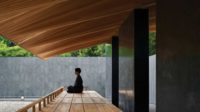Tokyo, Japan
SOM/NY; EDAW; Communication Arts; Fisher Marantz Stone; Buro Happold; Nikken Sekkei; Sakakura Associates; Jun Aoki
For years, the Japanese have been infatuated with Manhattan real estate. Timeless and elegant, New York landmarks fronting gracious avenues are everything that the vast majority of Tokyo buildings are not. But Tokyo Midtown, the latest in a series of mega-developments to emerge on the city’s skyline in the past five years, greets the street with Fifth Avenue flair. The 5-million-square-foot, mixed-use project is the product of a consortium of investors spearheaded by real estate giant Mitsui Fudosan who, fittingly, hired a veteran New York firm Skidmore, Owings & Merrill (SOM) to take the lead on design. Big and brawny, Tokyo Midtown, like Roppongi Hills just a few blocks away, was conceived and built in one fell swoop.

A cluster of six buildings created by different architects, Tokyo Midtown consists of office, residential, retail, restaurant, and cultural components intended to infuse the site with activity 24/7. While SOM produced Midtown’s three main office buildings, Sakakura Associates, in consultation with Jun Aoki, worked on its apartment complex. The Suntory Museum of Art and 21_21 DESIGN SIGHT (a small exhibition venue) came from architects Kengo Kuma and Tadao Ando, respectively. Two grand, wedge-shaped public spaces unite the primary buildings. Outdoors, a main plaza draws pedestrians in from Gaien Higashi Street in front, while inside, a 4-story shopping galleria looks out at the expansive greenbelt wrapping the site’s back (north) side. The project’s most prominent feature is its 54-story office tower crowned by a five-star hotel. At 814 feet high, the building has nudged out Kenzo Tange’s City Hall as the tallest in town.
The project began in 2001 when the Japanese government decided to sell a 17-acre property that most recently housed Japan’s Defense Agency headquarters. At the time, the government was promoting the redevelopment of designated areas in Tokyo to boost the country’s sluggish economy, says Yukio Yoshida, executive manager of the customer and public relations group of Tokyo Midtown Management. The sale of the site (at auction) was among Tokyo’s most expensive real estate transactions ever.
Mitsui Fudosan began by developing a master plan and a set of ground rules with local architects Nikken Sekkei. Economic demands fixed the office tower’s average floor plate at 46,500 square feet, and municipal regulations limited the building’s height and the number of hours it could cast a shadow on its neighbors each day—factors that all but dictated the tower’s midsite location. The task of converting these requirements into a comprehensive site strategy was given to SOM, which turned to traditional temple gardens for inspiration. “Our goal was not only to shape objects but to create spaces and places for people to enjoy themselves,” explains Mustafa K. Abadan, SOM’s design partner for the project.
PeopleDesign Architect Mustafa Abadan, FAIA, Design Partner Additional Design Team: Architect of record Associate architect(s) Midtown West Housing Building: Gardenside Restaurant Building: Suntory Museum of Art: Park Residences Main Plaza Canopy (design): 21_21 Design Sight (Museum): Interior designer: Hotel Interior Design: Park Residences’ Engineer(s): Main Plaza Canopy Consultant(s) Lighting (Concept Design): Retail Design: Art Design: Public Art Design: Signage Design: Installation Artist: General contractor: Photographer(s) Drawings:
|
ProductsExterior Cladding |



